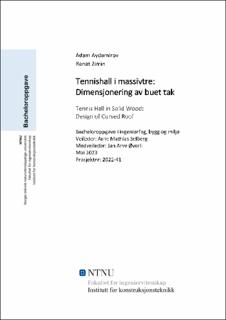| dc.contributor.advisor | Selberg, Arne Mathuas | |
| dc.contributor.advisor | Øverli, Jan Arve | |
| dc.contributor.author | Aydamirov, Adam | |
| dc.contributor.author | Zimin, Renat | |
| dc.date.accessioned | 2023-07-08T17:23:33Z | |
| dc.date.available | 2023-07-08T17:23:33Z | |
| dc.date.issued | 2023 | |
| dc.identifier | no.ntnu:inspera:146719958:71326395 | |
| dc.identifier.uri | https://hdl.handle.net/11250/3077386 | |
| dc.description.abstract | Denne oppgaven handler om å dimensjonere taket til en tennishall i Trondheim, hvor bæresystemet er konstruert av massivtre. Taket er utformet med en bueform, noe som tillegger ekstra utfordringer i prosjektet sammenlignet med et vanlig tak. Problemstillingen i oppgaven går ut på å bestemme største grad av bueform taket kan ha, samtidig som den tilfredsstiller brudd- og bruksgrensekravene.
Dimensjoneringen er gjort i samsvar med kravene og retningslinjene i Eurokodene. Det er utført en grundig kapasitetsanalyse på takelementet for å vurdere dets evne til å motstå belastninger fra moment, skjærkrefter og aksialkrefter som forekommer på grunn av permanente og variable laster som påvirker konstruksjonen. Basert på disse påvirkningene, er det valgt riktige dimensjoner for buekonstruksjonen for å oppnå tilstrekkelig styrke og stabilitet.
Oppgaven består av to deler. Den første delen innebærer selve dimensjoneringsanalysen som utføres for oppgaven. Den andre delen gir en beskrivelse av det teoretiske grunnlaget for analysen.
Bakgrunnen for oppgaven er det store klimaengasjementet som har funnet sted i moderne tid. Det har medført et større fokus i utforsking av nye bærekraftige løsninger. Massivtre er et godt alternativ til dette, som sammenfaller godt med Trondheim sin status som en foregangsby for bruk av massivtre.
Det ble gjennomført manuelle beregninger og kontrollert med lignende beregningseksempler fra Limtreboka. Bachelorgruppen kjørte ulike variasjoner av systemet på Excel, for å finne den varianten som maksimerte kapasitetsutnyttelsen. Buekonstruksjonen fikk tilfredsstillende kapasitet og endte opp med en høyde på 13,5 meter og en buevinkel på 53°. Valgte dimensjoner var 400 x 1500 mm. Det ble prøvd å modellere konstruksjonen i Focus Konstruksjon, som viste seg å ikke være så egnet til beregning av indre krefter i krumme elementer. | |
| dc.description.abstract | The bachelor thesis comprises a design check of the roof of a tennis hall in Trondheim, where the support system is constructed of solid wood. The roof is designed with an arched shape, which adds extra challenges to the project compared to a normal roof. The objective of the thesis is to determine the greatest degree of arch shape the roof can have, while satisfying the ultimate limit and serviceability limit requirements.
The design of the roof element is done in accordance with the requirements and guidelines in the Eurocodes. A thorough capacity analysis has been carried out on the roof element to assess its ability to withstand loads from moment, shear forces and axial forces that occur due to permanent and variable loads affecting the structure. Based on these loads, proper dimensions are chosen for the arch construction to achieve sufficient strength and stability.
The thesis consists of two parts. The first part involves the actual design process which is carried out for the roof-element. The second part provides a description of the theoretical basis for the analysis.
The background for the thesis is the major climate commitment that has taken place in modern times. This has led to a greater focus on exploring new sustainable solutions. Solid wood is a great alternative, which coincides well with Trondheim's status as a pioneering city for the use of solid wood.
Manual calculations were carried out and controlled with similar examples from the Limtreboka. The bachelorgroup ran different variations of the system on Excel in order to find the the variant that maximized the capacity utilization. The arched construction had a satisfactory capacity and ended up with a height of 13.5 metres and an angle of 53°. The dimensions chosen were 400 x 1500 mm. There was made an attempt to model the construction in Focus, which turned out to be not so suitable for calculating internal forces in curved elements. This is adressed in the thesis. | |
| dc.language | nob | |
| dc.publisher | NTNU | |
| dc.title | Tennishall i massivtre: Dimensjonering av buet tak | |
| dc.type | Bachelor thesis | |
